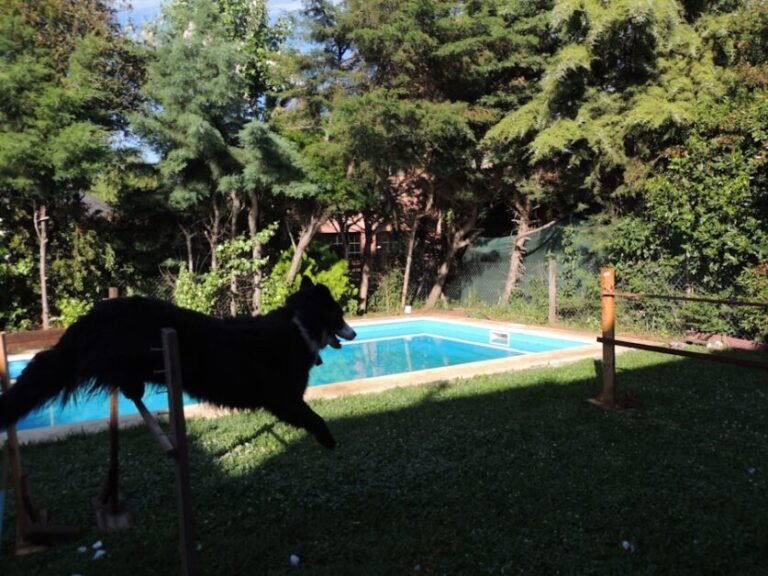The Ultimate Guide to Training Your Border Collie: Expert Advice and Techniques
Border Collies are a highly intelligent and energetic breed of dog that originated in the border region between England and Scotland. They were originally bred for herding livestock, particularly sheep, and their name reflects their origins. Border Collies are known for their exceptional herding abilities, as well as their agility, speed, and intelligence.
In terms of physical characteristics, Border Collies are medium-sized dogs with a well-proportioned body. They have a dense double coat that can come in a variety of colors, including black and white, red and white, and tricolor. Their eyes are one of their most distinctive features, as they are often a striking shade of blue or brown.
In addition to their physical attributes, Border Collies are also known for their highly trainable nature and their strong work ethic. They are incredibly intelligent dogs and have been ranked as one of the smartest dog breeds in the world. This intelligence, combined with their natural herding instincts, makes them excellent working dogs.
However, Border Collies are not just suited for working roles. They also make wonderful pets for the right owner. They are loyal, affectionate, and eager to please. They thrive in homes where they are given plenty of mental and physical stimulation, as well as opportunities to learn and work.
Preparing for Training: Setting Goals and Expectations
Before you begin training your Border Collie, it is important to understand their personality and learning style. Each dog is unique, and it is essential to tailor your training approach to suit your individual dog’s needs.
Border Collies are highly intelligent dogs that thrive on mental stimulation. They enjoy learning new tasks and solving problems. They also have a strong desire to please their owners, which makes them highly trainable. However, they can also be independent thinkers and may try to test boundaries or find ways to entertain themselves if they are not given enough mental and physical exercise.
When setting training goals and expectations for your Border Collie, it is important to be realistic. While they are highly trainable, it takes time and consistency to teach them new commands and behaviors. Start with simple commands and gradually build up to more complex tasks. Be patient and understanding, and remember that training is a lifelong process.
Creating a training schedule and routine is also crucial for success. Border Collies thrive on routine and structure, so having a consistent training schedule will help them understand what is expected of them. Set aside dedicated time each day for training sessions, and be consistent with your commands and expectations.
Positive Reinforcement Training: The Key to Success
Positive reinforcement training is widely regarded as the most effective and humane way to train dogs, including Border Collies. This training method involves rewarding your dog for good behavior, rather than punishing them for bad behavior.
The benefits of positive reinforcement training are numerous. It helps build a strong bond between you and your dog, as it creates a positive association with training sessions. It also encourages your dog to think and problem-solve, as they learn that certain behaviors result in rewards.
To effectively use positive reinforcement training with your Border Collie, you can use treats, toys, or praise as rewards. Find out what motivates your dog the most and use that as a reward during training sessions. For example, if your Border Collie is food-motivated, use small treats as rewards for good behavior. If they are more toy-motivated, use their favorite toy as a reward.
It is important to avoid punishment and negative reinforcement when training your Border Collie. Punishment can create fear and anxiety in dogs, which can lead to behavioral issues. Instead, focus on rewarding good behavior and redirecting unwanted behavior.
Basic Commands: Sit, Stay, Come, and Heel
Teaching your Border Collie basic commands is an essential part of their training. These commands provide the foundation for more advanced training and help establish boundaries and expectations.
To teach your Border Collie the “sit” command, start by holding a treat close to their nose and slowly move it upwards. As their head follows the treat, their bottom will naturally lower into a sitting position. Once they are in a sitting position, say the word “sit” and give them the treat as a reward. Repeat this process several times until they understand the command.
The “stay” command is another important command to teach your Border Collie. Start by having them sit in front of you. Hold your hand up in a stop signal and say the word “stay.” Take a step back and wait for a few seconds before returning to your dog and giving them a treat as a reward. Gradually increase the distance and duration of the stay as your dog becomes more comfortable with the command.
The “come” command is crucial for ensuring your Border Collie’s safety. Start by getting down on their level and saying the word “come” in an enthusiastic tone. When they come to you, reward them with praise and a treat. Practice this command in different environments and gradually increase distractions to ensure that your Border Collie will come to you reliably.
The “heel” command is used to teach your Border Collie to walk calmly by your side without pulling on the leash. Start by holding a treat in your hand and keeping it close to your leg. Begin walking, and when your dog is walking calmly by your side, say the word “heel” and give them the treat as a reward. If they start to pull or get ahead of you, stop walking and wait for them to come back to your side before continuing.
Advanced Commands: Roll Over, Shake, and Speak
Once your Border Collie has mastered the basic commands, you can move on to teaching them more advanced tricks and commands. These commands not only provide mental stimulation for your dog but also help strengthen the bond between you.
To teach your Border Collie to “roll over,” start by having them lie down on their side. Hold a treat close to their nose and slowly move it in a circular motion towards their shoulder. As they follow the treat with their nose, their body will naturally roll over onto their back. Once they are in the rolled-over position, say the word “roll over” and give them the treat as a reward. Repeat this process several times until they understand the command.
The “shake” command is a fun and interactive trick that can be taught using positive reinforcement. Start by having your Border Collie sit in front of you. Hold out your hand and say the word “shake.” When they lift their paw to touch your hand, give them a treat as a reward. Repeat this process several times until they understand the command.
Teaching your Border Collie to “speak” can be a useful command for alerting you to potential dangers or intruders. Start by getting your dog excited and worked up, such as by playing with their favorite toy or making high-pitched noises. When they start barking, say the word “speak” and give them a treat as a reward. Repeat this process several times until they understand the command.
Agility Training: Building Confidence and Coordination
Agility training is a popular activity for Border Collies, as it allows them to use their natural athleticism and intelligence in a fun and challenging way. It involves navigating an obstacle course consisting of jumps, tunnels, weave poles, and other obstacles.
There are numerous benefits to agility training for Border Collies. It helps build their confidence and coordination, as well as strengthens their bond with their owner. It also provides mental and physical exercise, which is essential for this high-energy breed.
To start agility training with your Border Collie, you can set up a simple course in your backyard or find a local agility club or facility. Start with basic obstacles, such as jumps and tunnels, and gradually introduce more complex obstacles as your dog becomes more comfortable.
When teaching your Border Collie agility skills, it is important to break down each obstacle into smaller steps. For example, when teaching them to jump, start with a low jump and gradually increase the height. Use positive reinforcement and rewards to encourage your dog to navigate the obstacles.
Herding Training: Honing Natural Instincts
Border Collies have a strong natural instinct for herding, and many owners choose to train their dogs in this discipline. Herding training allows Border Collies to use their natural abilities in a controlled and productive way.
The history of Border Collies as herding dogs dates back centuries. They were originally bred for their herding skills and were highly valued for their ability to control livestock. Today, while many Border Collies no longer work on farms, they can still participate in herding trials and competitions.
To teach your Border Collie basic herding skills, it is important to start with the basics. Begin by introducing them to livestock in a controlled environment. Use positive reinforcement and rewards to encourage them to approach the livestock calmly and without fear.
As your Border Collie becomes more comfortable around livestock, you can start teaching them basic commands such as “come by” (go clockwise around the livestock), “away” (go counterclockwise around the livestock), and “lie down” (stop and lie down). These commands are used to direct the dog’s movement and control the livestock.
Advanced herding training for working dogs involves teaching them more complex commands and techniques, such as driving the livestock forward or gathering them into a group. This type of training requires a high level of skill and expertise, so it is recommended to work with a professional trainer if you are interested in pursuing herding training with your Border Collie.
Socialization: Teaching Good Behavior with People and Other Dogs
Socialization is a crucial aspect of training for all dogs, including Border Collies. It involves exposing your dog to a variety of people, animals, and environments in a positive and controlled way. This helps them develop good behavior and manners, as well as reduces the risk of fear or aggression towards unfamiliar situations.
The importance of socialization for Border Collies cannot be overstated. They are highly intelligent and sensitive dogs that can become anxious or fearful if not properly socialized. Early socialization is particularly important, as it helps them develop into well-rounded and confident adults.
To socialize your Border Collie with people, start by introducing them to a variety of individuals of different ages, genders, and appearances. Encourage positive interactions by rewarding your dog with treats or praise when they approach people calmly and without fear. Gradually increase the level of interaction as your dog becomes more comfortable.
Socializing your Border Collie with other dogs is also important. Start by introducing them to well-behaved and friendly dogs in a controlled environment. Allow them to interact and play together while closely monitoring their behavior. Reward positive interactions and redirect any unwanted behavior.
It is important to note that socialization should be an ongoing process throughout your Border Collie’s life. Regular exposure to new people, animals, and environments will help keep them well-adjusted and confident.
Problem-Solving: Addressing Common Behavioral Issues
Like any breed, Border Collies can develop behavioral issues if not properly trained and managed. Some common behavioral issues in Border Collies include excessive barking, chewing, digging, separation anxiety, and herding behaviors.
Excessive barking is a common issue in Border Collies, as they are highly alert and vocal dogs. To address this issue, it is important to identify the underlying cause of the barking, such as boredom, fear, or territorial behavior. Once the cause is identified, you can use positive reinforcement training to redirect their behavior and reward calm and quiet behavior.
Chewing and digging are also common behavioral issues in Border Collies, particularly if they are not given enough mental and physical exercise. To address these issues, provide your dog with plenty of appropriate chew toys and outlets for digging, such as a designated digging area in your yard. Redirect their behavior to these appropriate outlets and reward them for using them.
Separation anxiety is another common issue in Border Collies, as they are highly bonded with their owners. To address separation anxiety, it is important to gradually desensitize your dog to being alone. Start by leaving them alone for short periods of time and gradually increase the duration. Provide them with plenty of mental and physical exercise before leaving to help tire them out.
Herding behaviors can also be problematic in Border Collies, particularly if they are not given an outlet for their natural instincts. To address this issue, provide your dog with opportunities to engage in herding activities, such as participating in herding trials or working with livestock under the guidance of a professional trainer.
If you are struggling to address behavioral issues with your Border Collie, it may be necessary to seek professional help from a certified dog trainer or behaviorist. They can provide guidance and support tailored to your specific situation.
Training for Specific Jobs: Search and Rescue, Therapy, and more
Border Collies are known for their versatility as working dogs and can be trained for a variety of specific jobs. Some common jobs that Border Collies excel at include search and rescue, therapy work, agility competitions, obedience trials, and flyball.
Search and rescue training involves teaching your Border Collie to locate missing persons or objects. This type of training requires a high level of obedience, focus, and problem-solving skills. It is recommended to work with a professional trainer or join a search and rescue organization to receive proper training and guidance.
Therapy work involves training your Border Collie to provide comfort and support to individuals in hospitals, nursing homes, schools, or other settings. This type of training requires a calm and friendly temperament, as well as good obedience skills. Many organizations offer therapy dog certification programs that can help guide you through the training process.
Agility competitions are a popular activity for Border Collies, as they allow them to showcase their athleticism and intelligence. Agility training involves teaching your dog to navigate an obstacle course consisting of jumps, tunnels, weave poles, and other obstacles. It is recommended to work with a professional trainer or join an agility club to receive proper training and guidance.
Obedience trials are another option for training your Border Collie. These trials test your dog’s obedience skills and ability to follow commands. They involve performing a series of exercises, such as heeling, sitting, staying, and coming when called. Many organizations offer obedience trials at various levels of difficulty.
Flyball is a fast-paced team sport that involves racing against other dogs over a series of hurdles to retrieve a ball. It requires speed, agility, and good obedience skills. Many flyball clubs offer training classes and competitions for dogs of all skill levels.
When training your Border Collie for specific jobs, it is important to find a professional trainer or join an organization that specializes in working with herding dogs. These trainers have the expertise and experience to understand the unique needs and instincts of Border Collies, and can provide guidance on how to properly train them for tasks such as herding livestock or participating in dog sports like agility or obedience trials. Additionally, joining an organization dedicated to herding or working dogs can provide access to resources, training events, and a community of like-minded individuals who can offer support and advice throughout the training process.








